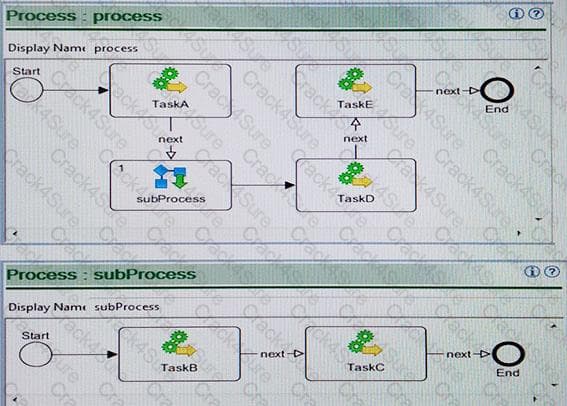We at Crack4sure are committed to giving students who are preparing for the Oracle 1z0-493 Exam the most current and reliable questions . To help people study, we've made some of our Oracle Communications Order and Service Management Server 7 Implementation Essentials exam materials available for free to everyone. You can take the Free 1z0-493 Practice Test as many times as you want. The answers to the practice questions are given, and each answer is explained.
Which configuration determines the data fields that are displayed when a user accesses the Summary Data tab in the Order Management Web client or performs a query for an order in the Task Web client?
You have the following process and subprocess configured in your OSM cartridge. The compensation strategy when a task needs to be re-evaluated is set to “Undo then Redo” for TaskB and “Redo” for all other tasks. On the other hand, the compensation strategy when a task is no longer required is set to “Undo” for all tasks. OSM has just completed the execution of TaskD when a revision is submitted, which causes all tasks to be re-evaluated. Which two tasks will be executed with the Undo execution mode?

You are designing a new fulfillment process for VPN sites for a communications service provider that wants to select manually if the supply chain activity should be executed or not. Considering that your implementation includes a manual task, which two options can you use to fulfill your client’s request?
Your OSM cartridge includes two structures at the same level as your order template:
- Customer structure with single cardinality and including information about customer profiles such as customerName, customerAddress, and customerContact
- Devices structure with multiple cardinality and including information about the physical elements associated with an order
A new activation system will interact with OSM, requiring a list of devices to activate and a customer profile to be associated for each device structure.
Which approach would you use to reflect this association in your order data, without causing a big impact on the existing modeling?
Which two types of fallout scenarios can be detected and notified by implementing a Jeopardy?
Your customer requests OSM to be installed in a highly available environment to support a large volume of inbound orders and outbound requests. Which three components of the OSM architecture would you consider to propose to your customer?
Your OSM solution fulfills orders originating from two different countries, C1 and C2. Two roles, R1 and R2, are created in your cartridges. Which design feature can you use to enable users with role R1 to view and manage orders only from country C1 and users with role R2 to view and mange orders only from country C2?
A requirement indicates that OSM should send a message to an upstream system when a manual task in your provisioning process reaches the Received state. How would you model this functionality in your cartridge?